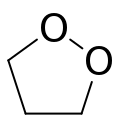1,2-Dioxolane

| |
| Names | |
|---|---|
| Preferred IUPAC name
1,2-Dioxolane | |
| Systematic IUPAC name
1,2-Dioxacyclopentane | |
| Identifiers | |
3D model (JSmol)
|
|
| ChemSpider | |
PubChem CID
|
|
CompTox Dashboard (EPA)
|
|
| |
| |
| Properties | |
| C3H6O2 | |
| Molar mass | 74.079 g·mol−1 |
Except where otherwise noted, data are given for materials in their standard state (at 25 °C [77 °F], 100 kPa).
| |
1,2-Dioxolane is a chemical compound with formula C3H6O2, consisting of a ring of three carbon atoms and two oxygen atoms in adjacent positions. Its condensed structural formula is [–(CH
2)3–O–O–].[1][2]
The compound is an organic peroxide, specifically an endoperoxide, and a structural isomer of the much more common 1,3-dioxolane, which is often called simply "dioxolane".
Synthesis
[edit]Synthesis methods for the 1,2-dioxolane core structure include oxidation of cyclopropane derivatives with singlet oxygen[3] or molecular oxygen with a suitable catalyst,[4][5] the use of autooxidation, nucleophilic displacement with hydrogen peroxide, treatment with mercury(II) nitrate, photolysis of extended π-systems,[6] reaction of a bis-silylperoxide and an alkene,[7] or reaction with a 2-perhydroxy 4-alkene with diethylamine[8] or mercury(II) acetate.[9][10]
Occurrence
[edit]Some derivatives occur naturally, for example in Calophyllum dispar and from the seeds of the mamey (Mammea americana).[6] Plakinic acid A (3,5-peroxy 3Z,5Z,7,11-tetramethyl 13-phenyl-8E,12E-tridecadienoic acid) and similar compounds were isolated from sponges of the Plakortis genus.[11][12] Nardosinone is a sesquiterpene derivative with a 1,2-dioxolane element isolated from the plant Adenosma caeruleum.[13]
Uses
[edit]Synthetic and natural dioxolane derivatives have been used or considered as antimalarial drugs.[6][7] Plakinic acid A and related compounds showed antifungal action.[11]
See also
[edit]References
[edit]- ^ Lay TH, Bozzelli JW (199). "Enthalpies of formation of cyclic alkyl peroxides: Dioxirane, 1,2-dioxetane, 1,2-dioxolane, and 1,2-dioxane". Chemical Physics Letters. 268 (1–2): 175–179. Bibcode:1997CPL...268..175L. doi:10.1016/S0009-2614(97)00168-1.
- ^ Demaison J (1982). "2.5.2.5 Elements with two or three internal rotors". Diamagnetic Molecules. Landolt-Börnstein - Group II Molecules and Radicals. Vol. 14a. pp. 415–425. doi:10.1007/10201404_40. ISBN 3-540-11365-7.
- ^ Akasaka T, Fukuoka K, Ando W (1991). "Formation of 1,2-dioxolane in the singlet oxygenation of cyclopropane". Tetrahedron Letters. 32 (52): 7695–7698. doi:10.1016/0040-4039(91)80568-Q.
- ^ Feldman KS, Simpson RE (1989). "Stereochemical studies on the preparation and subsequent reductive cleavage of 1,2-dioxolanes. Application to the synthesis of (±)-yashabushitriol". Tetrahedron Letters. 30 (50): 6985–6988. doi:10.1016/S0040-4039(01)93404-5.
- ^ Mata S, González J, Vicente R, López LA (2016). "Zinc-Catalyzed Multicomponent Reactions: Easy Access to Furyl-Substituted Cyclopropane and 1,2-Dioxolane Derivatives" (PDF). European Journal of Organic Chemistry. 2016 (15): 2681–2687. doi:10.1002/ejoc.201600393.
- ^ a b c Helesbeux JJ, Peyronnet D, Labaïed M, Grellier P, Frappier F, Seraphin D, et al. (December 2002). "Synthesis and antimalarial activity of some new 1,2-dioxolane derivatives". Journal of Enzyme Inhibition and Medicinal Chemistry. 17 (6): 431–7. doi:10.1080/1475636021000005677. PMID 12683680. S2CID 41059563.
- ^ a b Martyn DC, Ramirez AP, Beattie MJ, Cortese JF, Patel V, Rush MA, et al. (December 2008). "Synthesis of spiro-1,2-dioxolanes and their activity against Plasmodium falciparum". Bioorganic & Medicinal Chemistry Letters. 18 (24): 6521–4. doi:10.1016/j.bmcl.2008.10.083. PMID 18993067.
- ^ Liu HH, Jin HX, Wu YK (2010). "Synthesis and cleavage studies of a 1,2-dioxolane-type peroxide". Chinese Journal of Chemistry. 22 (9): 1029–1033. doi:10.1002/cjoc.20040220930.
- ^ Booldworth AJ, Tallant NA (1992). "1,2,4-Trioxane versus 1,2-dioxolane formation in the mercury(II) acetate-mediated cyclisation of hemiperoxyacetals derived from allylic hydroperoxides". Journal of the Chemical Society, Chemical Communications (5): 428. doi:10.1039/C39920000428.
- ^ Bloodworth AJ, Bothwell BD, Collins AN, Maidwell NL (1996). "A short synthesis of naturally occurring and other analogues of plakinic acids that contain the 1,2-dioxolane group A short synthesis of naturally occurring and other analogues of plakinic acids that contain the 1,2-dioxolane group". Tetrahedron Letters. 37 (11): 1885–1888. doi:10.1016/0040-4039(96)00143-8.
- ^ a b Phillipson DW, Rinehart Jr K (1983). "Antifungal peroxide-containing acids from two Caribbean sponges". Journal of the American Chemical Society. 105 (26): 7735–7736. doi:10.1021/ja00364a045.
- ^ Dai P, Trullinger TK, Liu X, Dussault PH (March 2006). "Asymmetric synthesis of 1,2-dioxolane-3-acetic acids: synthesis and configurational assignment of plakinic acid A". The Journal of Organic Chemistry. 71 (6): 2283–92. doi:10.1021/jo0522254. PMID 16526775.
- ^ Kandur WV, Richert KJ, Rieder CJ, Thomas AM, Hu C, Ziller JW, Woerpel KA (May 2014). "Synthesis and reactivity of 1,2-dioxolanes from β,γ-epoxy ketones". Organic Letters. 16 (10): 2650–3. doi:10.1021/ol500835f. PMID 24779430.
